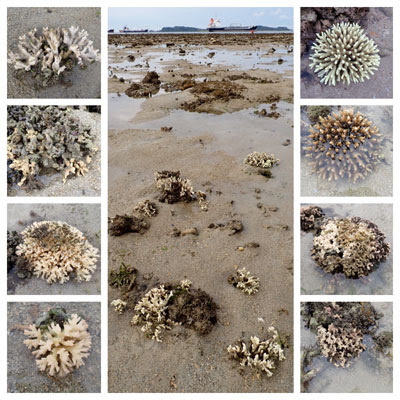We see signs of mass coral bleaching. There was widespread stress signs in hard and soft corals. We estimate about 10-20% were outright bleaching.
A great 360 view by Kelvin Yong shows just how big the terumbu is. Also, the surrounding islands and other submerged reefs nearby. Check out his full clips here.
The reef is still very much alive. The team spot nudibranchs, fishes, snails, octopus and other marine life.
 |
| Collage of photos by the team. Links to their albums at the end of this blog post. |
 |
| Collage of photos by the team. Links to their albums at the end of this blog post. |
I was glad to see some uncommon corals, most seemed alright. While most of the Circular mushroom corals were bleaching, others kinds of mushroom corals seem alright for now.
But some of the corals that were in the past the first to bleach were also bleaching. All Cauliflower corals I saw were bleaching some already with dead tips. Most of the Branching montipora corals too, some with large dead portions. Some Acropora were bleaching, others were not. The Sandpaper corals were pale but not full on bleaching.
Although pretty, these bright pastel colours don't bring us joy as they indicate the corals are stressed. High res photos of all cnidarian sightings on wildsingapore flickr.
I saw a wide variety of medium-sized to large leathery soft corals. Some were alright, many had pale patches or showing signs of stress (melting, breaking up into fragments). About 10% were outright bleaching.
Here's some of the range of normal to stressed to bleaching leathery soft corals that I saw.
Other cnidarians can also bleach, so I looked out for those too. A few Bubble tip anemones were seen by us, all full on bleaching - these anemones are often the first to bleach. I saw a few bleaching Frilly anemones but most I saw were alright. One Giant carpet anemone was a little pale, the rest I saw were okay. I also saw many Magnificent anemonesMagnificent anemones, none bleaching - I have never seen these anemones bleach even in full blown mass bleaching events. As with other nearby submerged reefs, there are a lot of Broad Feathery soft corals, they were mostly dark brown though very few patches had yellowish polyps. I saw one Asparagus flowery soft coral, it was a little yellowish. I saw a few small patches of bleaching corallimorphs and button zoanthids.
I saw the usual variety of sponges and they seemed alright. Though Rachael did see one sponge that was white with rotting patches.
I briefly checked up on the high shore and sprinkles of seagrasses evenly covered the shores (not much bare sand). Most of the seagrasses were heavily covered in hairy epiphytes. The most abundant seagrass was Spoon seagrass with tiny and with large leaves. I many clumps of Tape seagrass, many with longish leaves, longer than 30cm, and those that were cropped were not that short. This is similar to the northern part of this shore on our survey in May 2022.
Unfortunately, Richard and Russel came across large fish traps (bubu) laid on the reef edge (still submerged).
Future of Beting Bemban Besar
Beting Bemban Besar lies close to the planned 31ha reclamation at Eastern tip of Pulau Sudong. Other shores near the impact zone include Terumbu Bemban and Terumbu Raya.
Large areas nearby are also slated for massive reclamation outlined recently in the Long-Term Plan Review.
The Singapore Blue Plan 2018
Pulau Semakau and nearby islands and submerged reefs have been recommended by the Singapore Blue Plan 2018 for Immediate Conservation Priority. The Blue Plan recommends the intertidal and subtidal marine areas of Pulau Semakau and adjacent Pulau Hantu, and Pulau Jong to be designated Marine Reserve.
The Blue Plan highlights that Pulau Semakau and its associated patch reefs comprise many ecosystems: coral reefs, mangrove areas, intertidal sandflats, seagrass meadows, and coral reefs. The subtidal area of Pulau Jong is larger than the terrestrial area. Pulau Hantu is a popular dive site has seen increasing interest in the past decade due to biodiversity awareness. If protection is accorded to these three islands, zonation plans for use can be implemented to manage tourism and human impacts.
DOWNLOAD the Plan, SUPPORT the Plan! More on the Singapore Blue Plan 2018 site.
Posts by others on this survey
Che Cheng Neo
Rachael Goh
Tommy Tan
Kelvin Yong Part 1
Part 2
Part 3
Richard Kuah
Russel Low













